本文由 mar plus ask 授权mooool发表,欢迎转发,禁止以mooool编辑版本转载。
Thanks mar plus ask for authorizing the publication of the project on mooool, Text description provided by mar plus ask.
mar plus ask:我们在俯瞰地中海的马略卡岛(Mallorca)特拉蒙塔纳山脉(Tramuntana Mountains)的高处,建造并翻修了两幢隐世小屋。房屋四周环绕着数千年的橄榄树,橄榄树矗立在由干砌石墙构成的人造高台上。这片令人赞叹的风景优美的山区便是我们塑造的最美丽的案例之一,它向人们展示出了野生自然是如何与人工自然完美交织在一起的,也罕见的证明了人工有时可以创造出比原始自然更多的美。这里的大部分橄榄树和梯田都有超过1000年的历史,有些在罗马帝国灭亡时起就已存在,有些甚至在基督诞生之前就已经存在了,因此,基于其美景及其稀有资源,该地很快被联合国教科文组织列入了世界遗产名录。
mar plus ask:High up in the Tramuntana Mountains of Mallorca with views overlooking the Mediterranean Sea we have built and renovated two small off-grid houses. The houses are surrounded in all directions by thousand year old olive trees standing on high man-made terraces made out of dry stacked stone walls. This incredible scenic mountain area is one of the most beautiful examples we have on earth of how well wild and human-made nature can intertwine seamlessly, a rare example where Man has given more beauty to nature – than he has taken. Most of the olive trees and some of the terraces here are over a thousand years old, some old enough to have been alive during the fall of the Roman Empire, a few even the birth of Christ. The beauty of this place and that it ́s a response to scarcity rather than excess, has made the area an easy pick for the UNESCO World Heritage List.
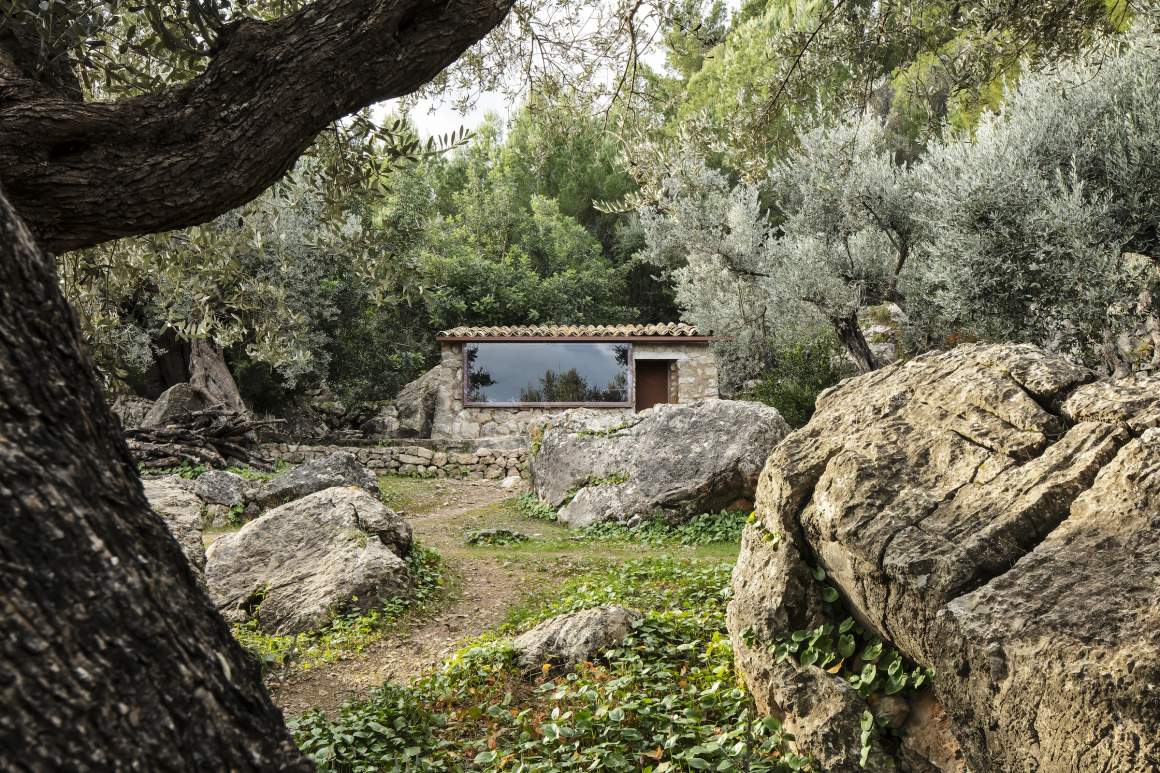
当我们想到这整个山坡的梯田都来自于人们的手工劳作,以及这些美丽的树木与阳光之间的相互映衬(它们的叶子一面是深色的,另一面是浅色的,更不用说它们那神秘扭曲的树干了)我们总是会感到阵阵惊奇。这些梯田似乎不受任何尖角和峡谷的影响,以精确的数学原理笔直地切入山坡,即使用今天的机器也很难完全复制出来,所以,如果说有什么东西可以用以象征整个地中海地区的话,那我们认为一定是马略卡岛上的橄榄树。
尽管从山谷看上去橄榄树山坡非常统一,但它们实际上是由相对较小的地块拼接而成的,这些地块通常由家族世代私有,时至今日,也仍有许多家庭引以为豪,并投入辛勤劳动来维护干燥堆积的石阶和植被,也正因如此,每个地块上都会设有一个用来存放工具的小石头房子,以及一个用来做午餐或者吃午饭的地方,当然可能́还会有一个在中午阳光最强烈的时候,用于午睡的小型可折叠长椅。这项管理工作到今天仍然被认为是岛上最好的职业之一。所以当你在上山或下山的路上看到这些自豪的工人时,他们总会带着一种安详的表情和一种似乎天生的平静来迎接你。
It always amazes us to think of the manual work that has been put into transforming whole mountain sides into terraces with these beautiful trees with their interplay of light; their leafs one side dark glossy the other light matte – not to mention their mysterious twisted trunks. With mathematical precision the terraces cuts into the hillsides in straight lines, seemingly unaffected by sharp corners and gorges. Even with todays machinery it seems impossible to redo and makes it very easy for us today to imagine the importance of olive trees on Mallorca, that if anything is the symbol of the Mediterranean region as a whole.
Despite how uniform the olive tree hillsides may look from the valleys, they are actually a huge patchwork of relatively small plots usually owned by families for generations. Even today many families take great pride and invest the hard labour it demands to maintain the dry stacked stone terraces and the vegetation in general. Therefore you will always find a small stone house on each plot that serves to shelter tools, but more importantly a place to make a paella or a stew for lunch, most likely there ́s also a small foldable daybed to take a siesta when the sun is hardest. Still to this day this job is regarded as one of the finest occupations on the island, when you see these proud working people on your way up or down, they meet you with a certain peaceful look and a calm nature.
▼项目设计师 Designer – Mar Vicens Fuster and Ask Anker Aistrup
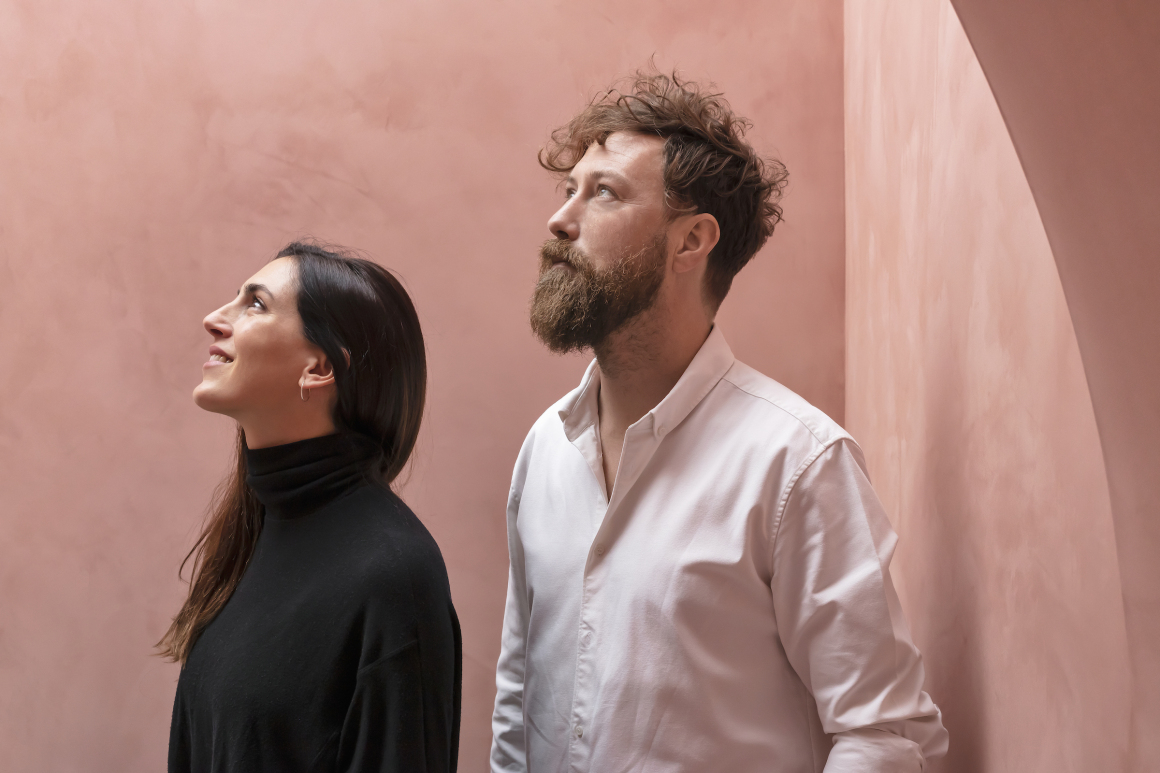
在这片土地上,你会发现有许多从陡峭的山坡上滚下来猛犸象大小的巨石,它们散落在树木之间的空地上,逐渐成为了一种天然的纪念雕塑。据说这些巨石仍在下沉,但由于人类寿命较短,无法真正欣赏它们的慢舞,只有不停生长的橄榄树才能看到这一点。在这里,时间不是以分钟、小时甚至是年来计算的,而是以千年来计算的。面对像这些橄榄树一样古老的生物,人类会开始学会谦卑。
Scattered around the property you’ll find solitary mammoth-sized boulders that rolled down the steep slopes and now lies here as natural monumental sculptures making up a clearing between the trees. It is said that the boulders still wander downwards, but that humans live to short to grasp their slow dance, only the olive trees grows old enough to see this. Up here it does not feel like time is counted in minutes, hours or even years – but in millennia. To face something living that is as old as these olive trees is a humbling experience.
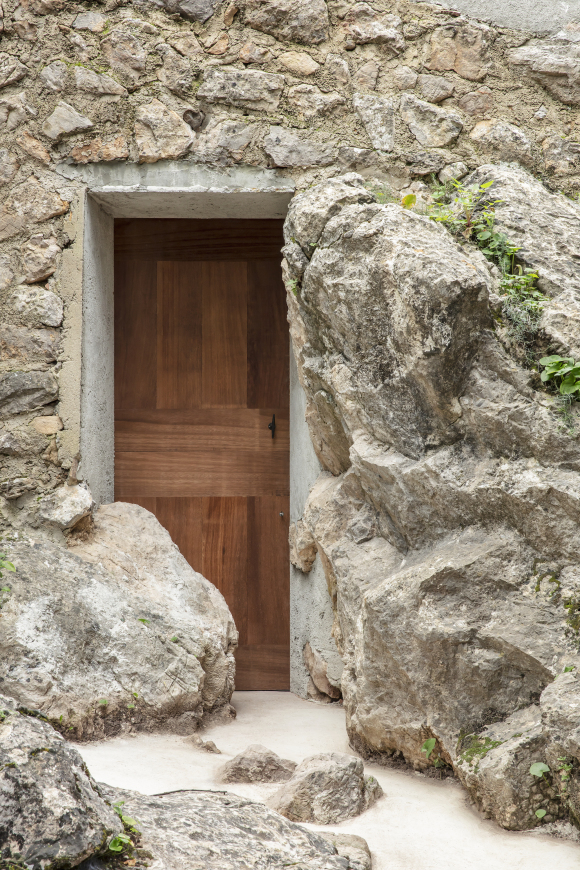
如果你想在画要在这里建造的东西时手不发抖,你必须非常确信自己作为建筑师的技能。当时我们的第一想法是,只有当我们能想出一些能以尊重和美化的方式增加一些东西时,我们才会考虑增设建造,然而实际上,我们希望建造的功能空间与该地区现有的结构几乎吻合:一间厨房,一个壁炉和一张双人床——考虑工人住宿至少需要一周时间,所以我们另外增设了淋浴间、水池、烧柴炉、电灯和由几块小型太阳能板制成的冰箱。
You have to be very convinced of your own skills as an architect if your hands aren’t trembling when sketching something to be built here. Our first reaction was that only if we could come up with something that would add something in a respectful and beautiful way, would we ever consider building. However it was calming that the functions we were looking to build wouldn’t be much different than those of the existing structures found in the area; a kitchen, a fireplace and a double bed – and as the stays would be minimum a week we added a shower, sink, wood fired oven and electricity for light and a fridge made by a few small solar panels.
通常,我们会在设计前列出一些基本原则,而根据当前的场地状况,第一个显而易见的原则就是,我们不会影响或砍伐任何橄榄树,这就大大减少了我们的建设用地。第二个是不移动岩石,这后来也成为了我们一个至关重要的决定。
在仔细观察了附近的房子后,我们发现他们在80厘米厚的石墙里只建了一两个小窗户,为了保持空间凉爽,有些建筑就像梯田一样,建在倾斜的山坡上,然而,日夜的温差会让室内变得潮湿,这就需要壁炉在一天的大部分时间里保持低燃来解决这个问题,从而给室内保持一个完美的温度,同时提供一点光线。这对我们非常有吸引力,因为它不仅能让房子在酷暑中保持凉爽,同时也是一个空间概念:带有开放式壁炉的半地下封闭空间,多少会让人想起最古老的空间原型,也就是人类的第一个家——山洞。我们发现洞穴或镂空空间的有趣之处在于其材料的一致性。于是这便自然成为了该“粉色房屋”的设计概念:一个保护性的封闭空间,一种超现代的空间,繁衍千年的人类后代又回到了我们原来的家。
就像黑白电影一样,减少颜色和材料使用会使得原本的形状和纹理变得更加突出,因此我们对所有内部表面都采用统一的处理方法,选用了带有一点橙色的粉色灰泥。选择这种颜色的原因有很多种,其中之一就是它́很好地补充了橄榄树叶子的哑光面,除了这种漂亮的互补外,它还起到了一定的视觉补充作用,从内部看过去,橄榄树在场景中会变得更加清晰。
We normally lay out some basic dogmas and in this case the first one was obvious; we will not touch or cut any olive trees. That reduced our list of places to build significantly. The second was that of not moving rocks, which later became a pivotal decision.
When looking at houses nearby we saw that they were built in up to 80cm thick stone walls with only one or two small windows. Some of the buildings were built into the sloped mountainsides exactly like the terraces, all of which serves to keep them cool. The difference of temperature however makes the interior humid, which is then solved by letting the fireplace burn low most of the day to keep a perfect temperature and to give a little light. This appealed very strongly to us as a solution to keep the house cool in the tough summer, but also as a spatial idea; a half underground inclosed space with an open fireplace, somewhat reminiscent of the oldest archetype of space but also man’s first home; a cave. What we find interesting about caves or carved out spaces is the uniformity of its material. This became the idea for “pink house”, a protective enclosed space, a sort of hyper modern space with relatives going back to the first home of man.
Like a black and white movie, reducing colors and materials will make shapes and textures stand out more, therefore a unifying treatment of all the interior surfaces, a pink stucco with some drops of orange was chosen. The color was chosen from a number of different reasons, one being that it ́s the exact complementary color of the matte side of an olive tree leave, that besides being beautiful together, has the optic side effect that the olive trees seen from inside seems more defined.

当我们决定在建筑中融入一块大石头时,这种房子和自然之间的游戏便得到了进一步的加强。对我们来说,这些石头现在变成了艺术品,房子是它的镂空背景,成为了它的照明灯箱。这让我们感到非常高兴,于是顺势开设天窗,让阳光从上方照亮它,在完美的曲线和垂直度之间进行过渡——所有这些都只为给石头创建一个合适的新家。人们可以在它旁边的淋浴间用冷水淋浴,冷水由外部和屋顶上的沉淀物收集过滤而来。在淋浴间旁边,我们设置了一个敞开的壁炉,在最远处放了一张长床。房屋外部都由干石堆砌而成,只有一扇巨大的柚木推拉门,随着时间的推移,它会像石头一样变成灰色,从外部开始展示房子。
This play between house and nature, was further enhanced when we (literally) decided to embrace a big stone. To us the stone became the piece of art – suddenly the house was more about sculpting it ́s backdrop and being its lightbox. That fact pleased us immensely. We lit it from above with a skylight and played with the transition between a perfect curve and verticality – all to give the stone an appropriate new home. Man could shower next to it with cold water collected and filtered through a multiple layered mess and a deposit on the roof. Next to the shower we placed an open fireplace and in the furthest end a long bed. The exterior was built in dry stack stones, only a big sliding door build in teak wood, that turns grey like the stones with time, reveals the house from outside.
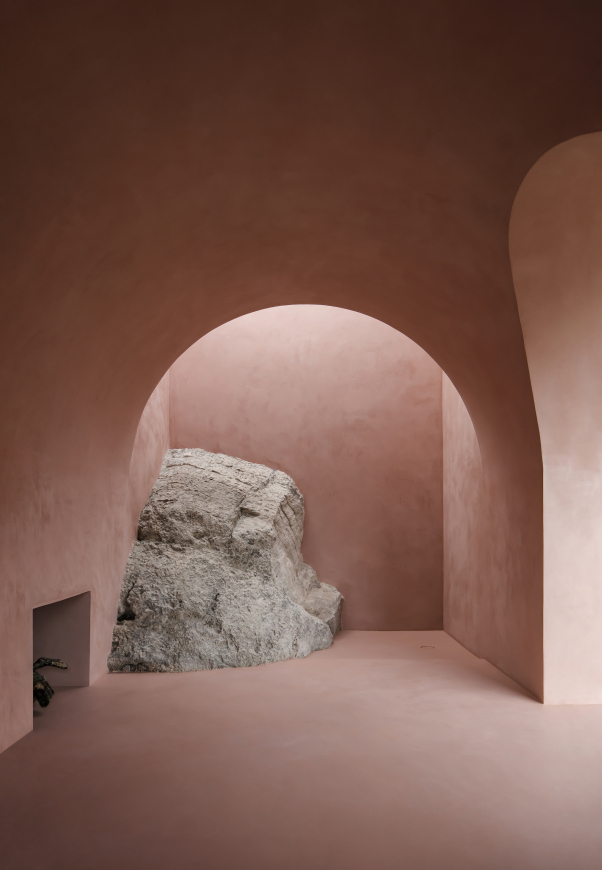
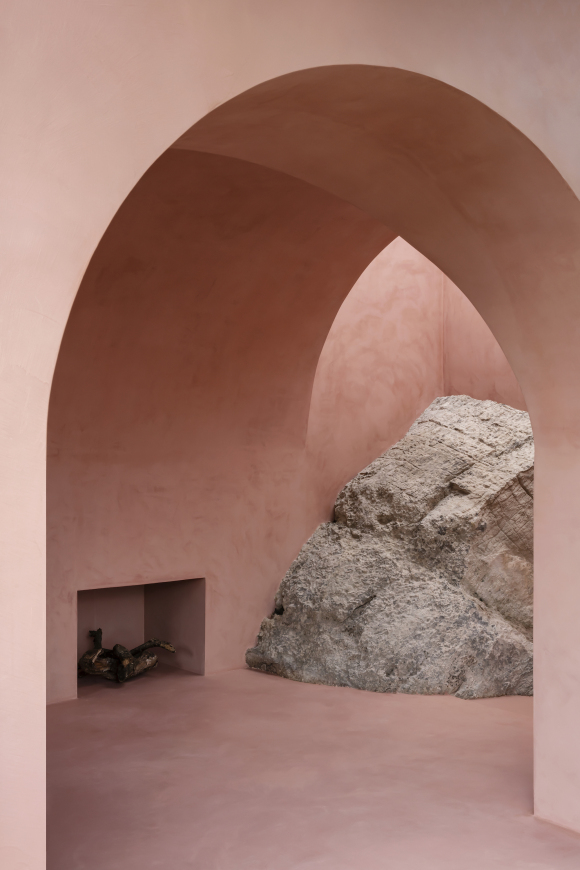
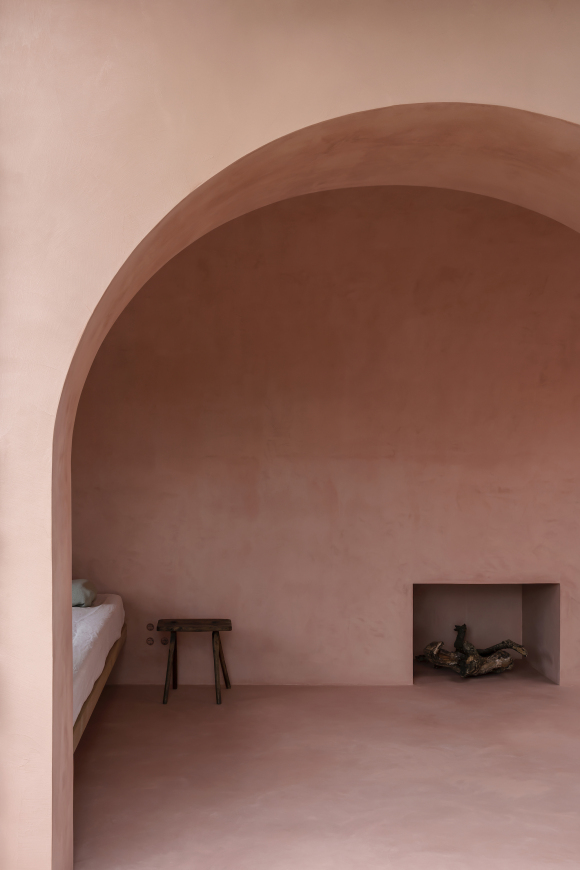
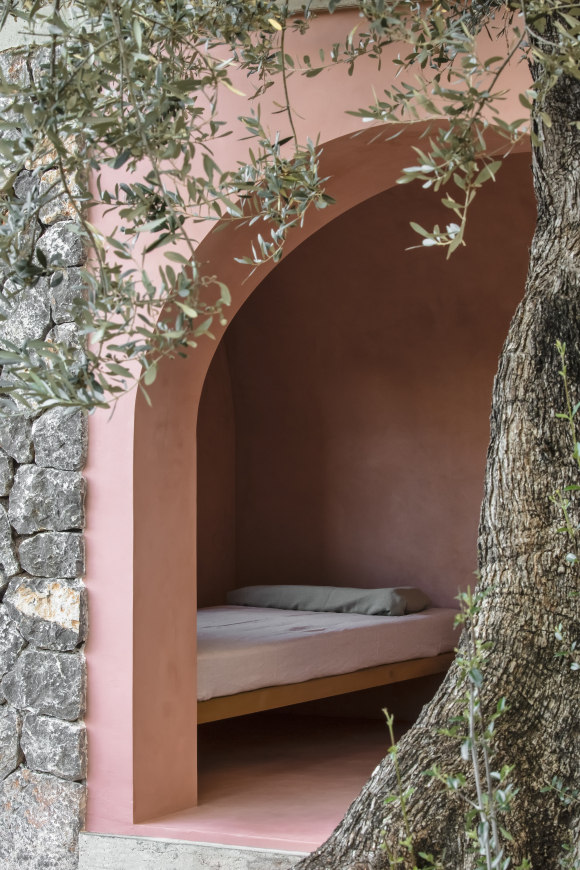
“紫色房屋”是一个用于存放工具的小型现有建筑。这座有着数百年历史的房子之所以建在岩层上,是为了节省时间和减少手工切割石头的数量。房子内只有一扇靠近岩层的窗户,我们把它改成了入口。同时,为了能像粉色房屋一样,模糊自然和住宅之间的界限,我们在岩石之间铺设了曲线混凝土地面。这个小小的改变对这个空间产生了很大的影响,使它神奇地变成了一个我们非常喜欢的半自然半驯化的户外空间。房子内部设有厨房、餐厅和卫生间。
The “Purple House” was a small existing structure used for tools. The many hundred year old house was built against a rock formation, simply to save time and minimise the amount of hand cut stones. The house had only one window which was placed next to the rock formation, which we decided to change into the entrance. Like Pink House we decided to blur the lines between nature and house, by paving the floor between the rocks with fluid concrete. This rather small transformation had a big impact on the space, and made it into a quite weirdly magically half nature / half domesticated outdoor space that we are very fond of. The house was to contain the kitchen functions, a dinning room, as well as a restroom.
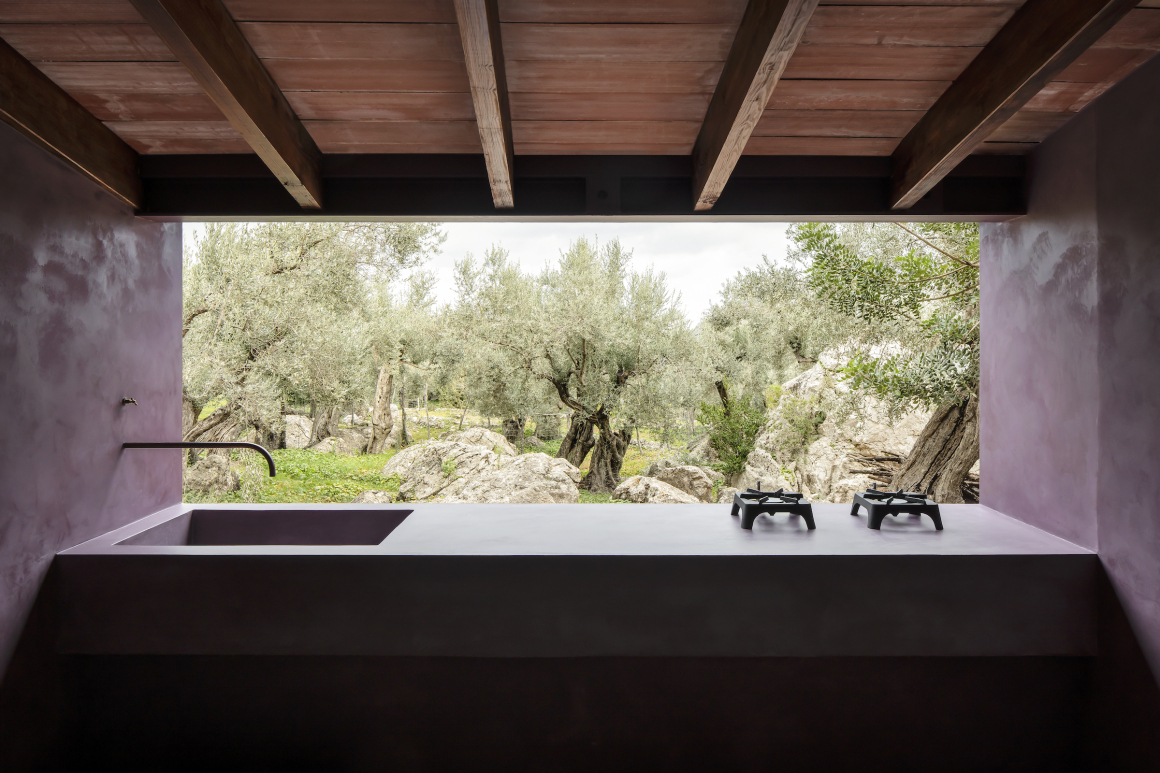
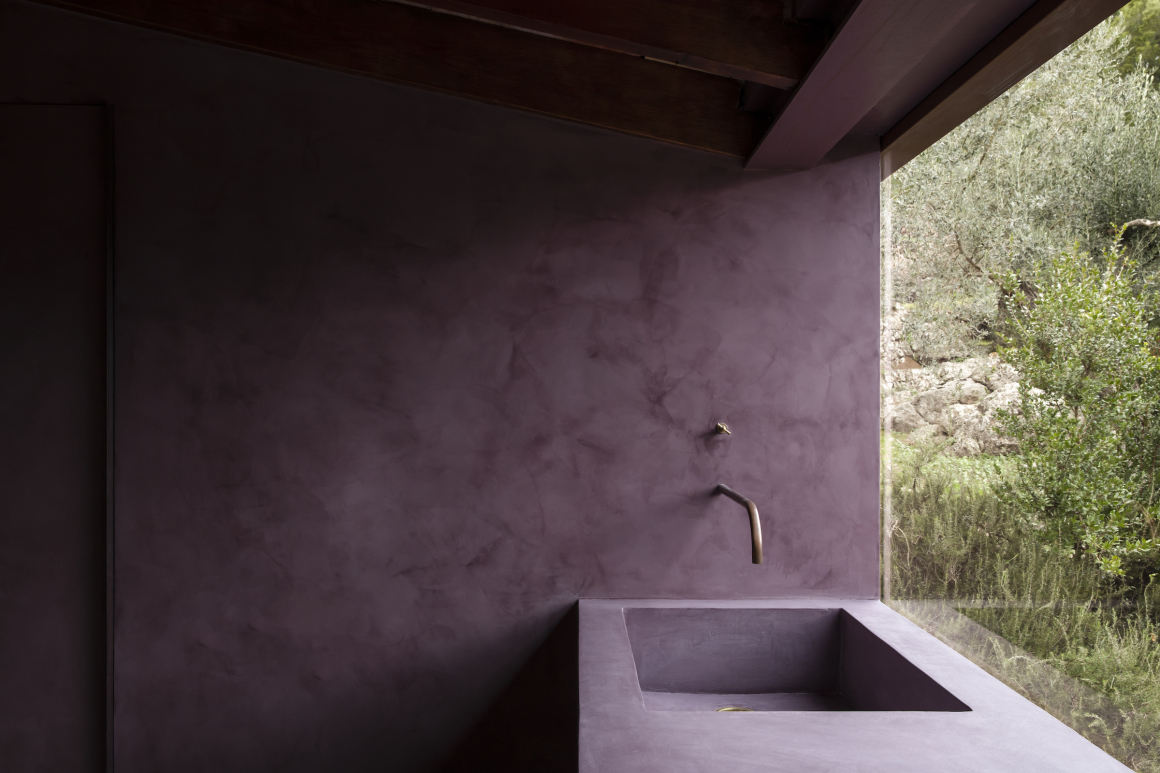
然而,无论我们如何尝试增加厨房,空间都会变得狭窄,后面我们突然想到,我们可以把60厘米厚的石头变成我们的优势,在墙壁上做一个长切口,利用墙的深度作为厨房空间。这里的顶部给了我们一个全景视角,墙上巨大的无框窗户更是增强了这一效果,且支撑着窗户的U形梁同时又可以充当厨房水槽。紫色的墙壁是橄榄树叶子深暗而有光泽的一面的互补色。厨房内设有一个大水槽、一个烧柴炉和两个燃气灶,其用水则来自住宅最高点的泉水。
However the space became too narrow no matter how we tried to add a kitchen, we then suddenly realised that we could turn the 60cm thick stone into our advantage; by making one long cut we could use this depth of the wall as the kitchen. This on top gave us a panoramic view, enhanced by an enormous (from in) frameless window, carried by a U-beam that doubles as a gutter. The purple color on the wall is the complementary color of the dark and glossy side of the olive tree leaf. A big sink, a wood fired oven and two gas burners are found in the kitchen – while water is provided from a spring on the highest point of the property.
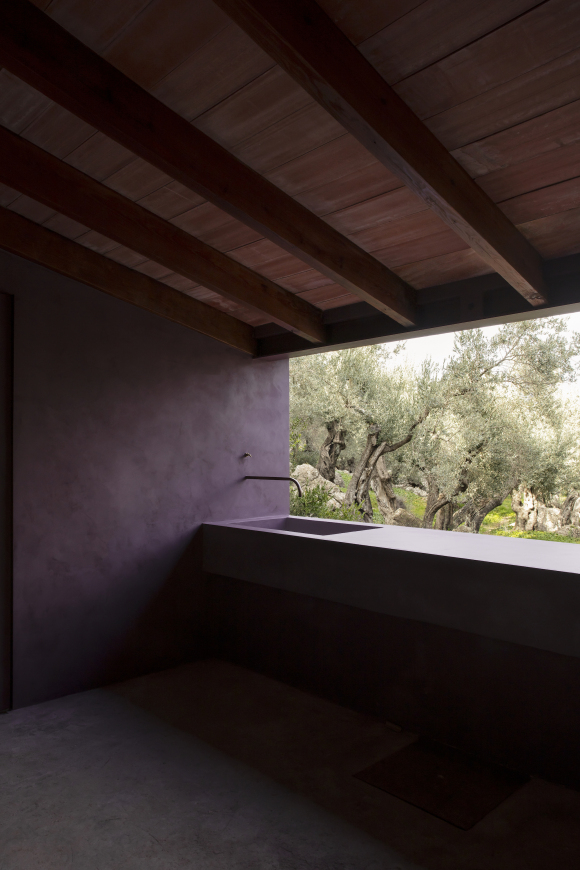
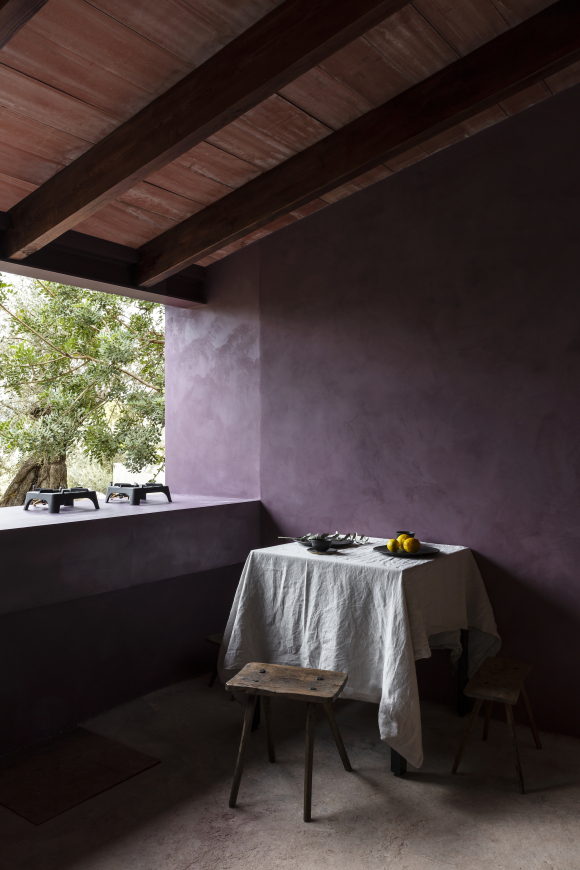

地点:西班牙马略卡岛
完成:2019年
摄影师:Piet Albert Goethals
Location: Mallorca, Spain
Year: 2019
Photographer: Piet Albert Goethals
更多 Read more about: mar plus ask


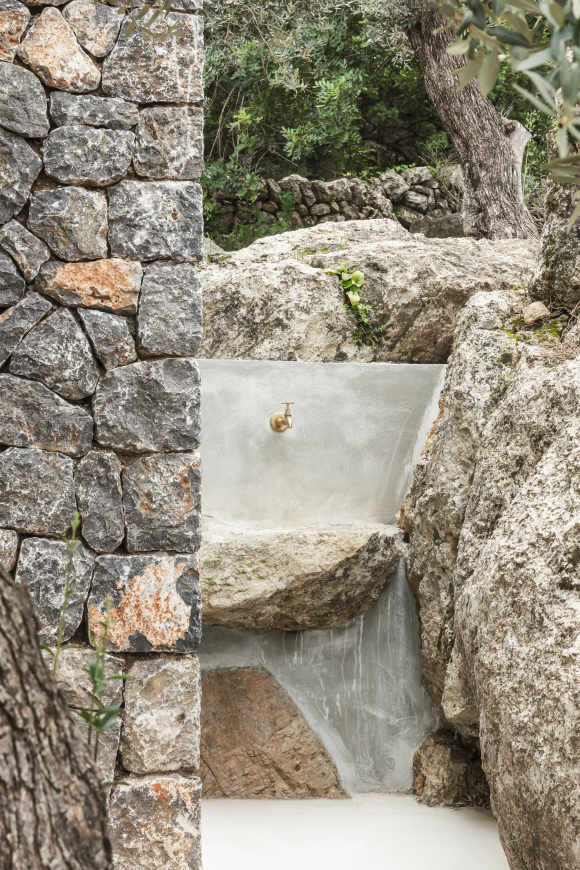
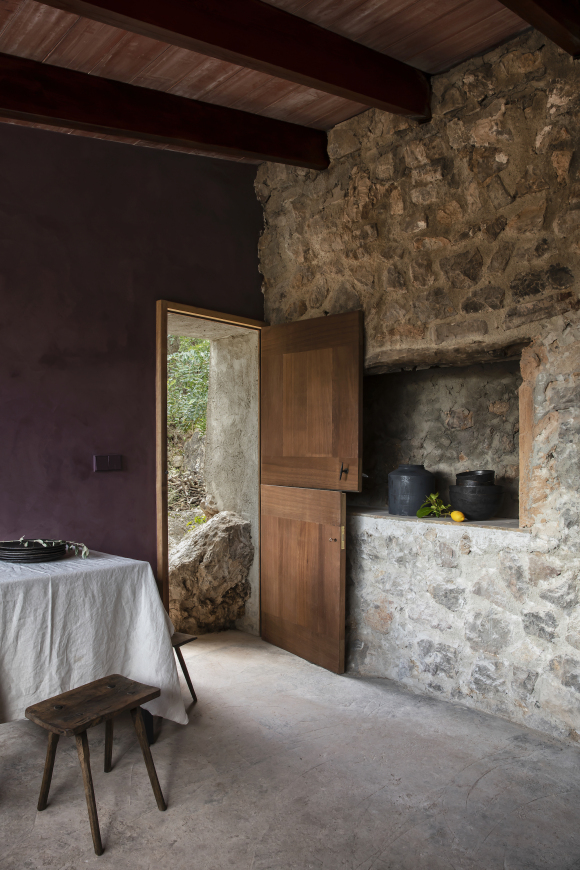


0 Comments